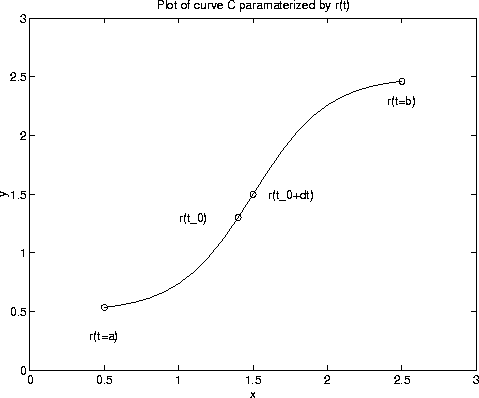This page has the following sections:
Line Integrals with Respect to Arc Length
Consider the following problem: a piece of string, corresponding to a curve C, lies in the xy-plane. The mass per unit length of the string is f(x,y). What is the total mass of the string?
The formula for the mass is
![]()
The integral above is called a line integral of f(x,y) along C. It is also called a line integral with respect to arc length.
Question: how do we actually evaluate the above integral? The strategy is: (0) parameterize the curve C, (1) cut up the curve C into infinitesimal pieces, (2) determine the mass of each infinitesimal piece, (3) integrate to determine the total mass. It is assumed that C is piecewise smooth. That is, it is a union of finite number of smooth curves.
Suppose that we can describe the curve by the vector function r(t)=<x(t),y(t)> where a<=t<=b. Consider a portion of the curve corresponding to the infinitesimal interval t_0<=t<=t_0+dt.

The arc length of the curve, ds, on this interval is
![]()
Hence, the mass of the piece (density times length) is
![]()
The total mass of the string is the sum of all the masses of all infinitesimal pieces
![]()
The integral on the right is an integral of one variable.
Line integrals are not restricted to curves in the xy plane. If C is a curve in three dimensions parameterized by r(t)=<x(t),y(t),z(t)> with a<=t<=b, then
![]()
Find the mass of the piece of wire described by the curve x^2+y^2=1 with density function f(x,y)=3+x+y.
The circle of radius 1 can be parameterized by the vector function r(t)=<cos(t),sin(t)> with 0<=t<=2*pi. We have x(t)=cos(t) and y(t)=sin(t), so x'(t)=-sin(t) and y'(t)=cos(t). The mass is given by the formula
![]()
The term in the square root is 1, hence we have
![]()
Line Integrals with Respect to x, y, and z
In some applications, such as line integrals of vector fields, the following line integral with respect to x arises:
![]()
This is an integral over some curve C in xyz space. It can be converted to integral in one variable. Suppose that C can be parameterized by r(t)=<x(t),y(t),z(t)> with a<=t<=b. Then,
![]()
There are analogous formulas for integrals with respect to y and z.
In some applications, integrals with respect to x, y, and z occur in a sum:
![]()
If C is a curve in the xy plane and R=0, it might be possible to evaluate the line integral using Green's theorem.
Using the standard parameterization for C, this last integral becomes
![]()
Evaluate the line integral
![]()
where C is the circle in the figure above.
Recall that the circle is parameterized by r(t)=<cos(t),sin(t)> with 0<=t<=2*pi. Hence, x(t)=cos(t), y(t)=sin(t), and y'(t)=cos(t). According to the discussion above,
![]()
Copyright © 1996 Department of Mathematics, Oregon State University
If you have questions or comments, don't hestitate to contact us.